 W
WThe Alaska pollock or walleye pollock is a marine fish species of the cod genus Gadus and family Gadidae. It is a semi-pelagic schooling fish widely distributed in the North Pacific, with largest concentrations found in the eastern Bering Sea.
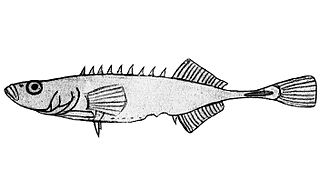 W
WThe Amur stickleback is a species of fish in the family Gasterosteidae. This freshwater, brackish water, or marine benthopelagic fish is usually 6.5 cm in length. It is widespread in East Asia: off the Korean peninsula, northeast and north China, Japan, the Kuril Islands, the Kamchatka peninsula, and the basin of the Amur River.
 W
WThe Japanese anchovy is a schooling fish of the family Engraulidae. It is common in the Pacific Ocean south from the Sea of Okhotsk, widespread in the Sea of Japan, Yellow Sea, and East China Sea, and near the coasts of Japan. They live up to 2–3 years, similar to European anchovy. They spawn from Taiwan to southern Sakhalin.
 W
WArctoscopus japonicus, the sailfin sandfish or Japanese sandfish, is a species of fish of the Percomorpha (perch-like) clade in the order Trachiniformes, being one of the two genera in the family Trichodontidae, the sandfishes. Known in Japan as hatahata , it is a commercially important fish especially for Akita and Yamagata prefectures. Its habitat occurs in sandy-mud bottoms ranging from the Sea of Japan to the Okhotsk Sea.
 W
WThe Asian sheepshead wrasse, Semicossyphus reticulatus, is a species of wrasse, one of the largest, native to the western Pacific Ocean, where it is only known from around the Korean Peninsula, China, Japan, and the Ogasawara Islands, where it inhabits rocky reef areas. It can reach 100 cm (39 in) in total length and the greatest weight recorded for this species is 14.7 kg (32 lb). This species is valued as a food fish in its native range.
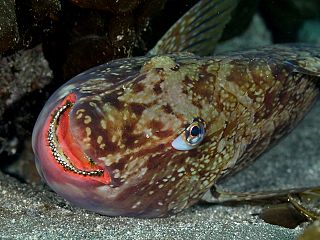 W
WCalotomus japonicus, commonly known as the Japanese parrotfish, is a species of parrotfish commonly found throughout the northwest Pacific. The species has been classified as Least Concern by the IUCN.
 W
WThe Chinese sleeper, also known as the Amur sleeper, is a species of freshwater sleeper native to Amur River basin in eastern Asia with introduced populations in other regions of Eurasia. It is currently the only known member of its genus.
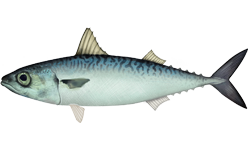 W
WThe chub mackerel, Pacific mackerel, or Pacific chub mackerel is a species of fish in the tuna and mackerel family, Scombridae. This species of mackerel closely resembles the Atlantic chub mackerel.
 W
WCoilia nasus, also known as ungeo and the Japanese grenadier anchovy or Chinese tapertail anchovy is a fish from the family Engraulidae (anchovies). It grows to 41 cm (16 in) total length; it is a relatively large species for its genus. It is found in marine, freshwater, and brackish water at depths down to 50 m (160 ft). It is an example of an anadromous fish species, with some populations moving to freshwater to spawn. Overall they are distributed in the northwest Pacific, between 21–42°N and 109–134°E, or from Guangdong in China to the west coast of the Korean peninsula and the Ariake Sound in southwestern Japan. A traditional delicacy, the species is commercially fished in Korea, China and Japan. In China it is one of the most expensive fish sold, and as the he anadromous variety is more expensive than the freshwater variety, the industry is mostly focussed in the Yellow Sea, East China Sea, and Yangtze.
 W
WThe common carp or European carp is a widespread freshwater fish of eutrophic waters in lakes and large rivers in Europe and Asia. The native wild populations are considered vulnerable to extinction by the International Union for Conservation of Nature (IUCN), but the species has also been domesticated and introduced into environments worldwide, and is often considered a destructive invasive species, being included in the list of the world's 100 worst invasive species. It gives its name to the carp family, Cyprinidae.
 W
WCzekanowski's minnow is an Asian species of small freshwater cyprinid fish. It is found in Russia, China, Korea, and Mongolia.
 W
WThe dark sleeper, Odontobutis obscura, is a species of freshwater sleeper native to China, Japan, and Korea. This species can reach up to 25 cm (9.8 in) in length. It is a commercially important species.
 W
WThe Japanese dragonet is a species of dragonet native to the northwestern Pacific Ocean, where it is known from the waters off of Japan and South Korea. It can be found on coral or rocky reefs at depths of 10 to 20 metres, in preferred water temperatures of 18 to 22 °C. It is also found in the aquarium trade. This species reaches a length of 7 centimetres (2.8 in) SL and 10 centimetres (3.9 in) TL.
 W
WThe Rikuzen flounder is a flatfish of the family Pleuronectidae. It is a demersal fish that lives on sandy and muddy bottoms in temperate waters at depths of between 42 and 200 metres. Its native habitat is the northwestern Pacific, particularly the Sea of Japan and the coastlines of Japan and Korea. It grows up to 22 centimetres (8.7 in) in length.
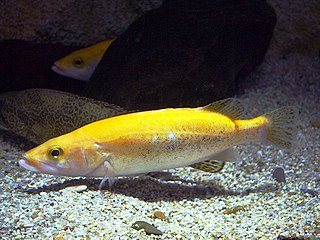 W
WThe golden mandarin fish, also known as the leopard mandarin fish, is a species of freshwater ray-finned fish, an Asian perch from the family Sinipercidae, which is native to eastern Asia. This species can reach at least 33.4 cm (1.1 ft) in standard length and 607.3 g (1.34 lb) in weight. It is typically yellowish-brown with blackish-brown speckles ("leopard"), but there are also bright yellow ("golden") individuals, which are particularly prized in Korea and selectively bred in captivity.
 W
WHemibarbus mylodon is a species of freshwater cyprinid fish endemic to Korea. It is commonly called spotted barbel or Korean doty barbel. It inhabits the upper stream of Imjin, Han and Geum River. As of 2008, it is classified as endangered species.
 W
WHippocampus haema, the Korean seahorse, is a seahorse of the family Syngnathidae native to the northern Pacific Ocean, and it usually lives in Sargassum and weeds on shallow soft bottom habitats from 0 to 18 m depth. The Korean seahorse is the most common seahorse in Korean waters so that the scientific name 'haema' is named from 'seahorse' in Korean. The Japanese name 'Himetatsu' is derived from its smaller shape such as body and coronet rather than the shape of a sister species, crowned seahorse. This species had been repeatedly misidentified as crowned seahorse and Shiho's seahorse before a taxonomic review. However, the two genuine species do not live in Korean waters, therefore this species was handled by naming a new scientific name, Hippocampus haema. It can grow to lengths of 11 centimeters, but more commonly 6 to 8 centimeters as adult. Namely, the length of juvenile is 1 to 5 centimeters, whereas and the lengths of males and females reaching sexual maturity are considered as ca. 5 centimeters with or without male brood pouch. However, sex determination of this species is considered as ca. 2 centimeters from anatomic examination of gonad. This species has sexual dimorphism, the difference is male has a longer tail, while female has a longer trunk for same size. Breeding season of this species is from May to November, relating to warm water temperature.
 W
WThe shuttles hoppfish or shuttles mudskipper is a species of mudskippers native to fresh, marine and brackish waters of the northwestern Pacific Ocean from Vietnam to Korea and Japan. This species occurs in muddy estuaries, tidal flats and swamps and marshes and is capable of remaining out of the water for up to 60 hours so long as it is kept moist. This species can reach a length of 10 centimetres (3.9 in) TL. This species can also be found in the aquarium trade and is also used in traditional Chinese medicine.
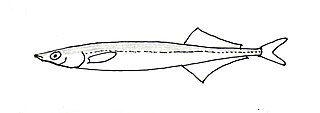 W
WHypoptychus dybowskii, the Korean sandlance, is a species of hypoptychid fish found in shallow salt water off the coasts of Japan and Sakhalin (Russia) as well as possibly occurring in South Korea and China. It is a commercially important species where it occurs. This species grows to a length of 10 centimetres (3.9 in) TL. This species is the only known member of its genus.
 W
WThe ice goby is a species of goby in the subfamily, Gobionellinae, and the only member of the monotypic genus Leucopsarion. It is native to the northwestern Pacific Ocean, where it occurs in China, Japan, and Korea. Its English language common name is ice goby, and in Japanese it is known as shiro-uo. In Japan, where it is a delicacy, it is also called shirauo no odorigui.
 W
WThe elongate ilisha, also known as the Chinese herring or slender shad, is a species of longfin herring native to the coastal waters and estuaries of North Indian Ocean and Northwest Pacific. It is a relatively large species, up to 45–60 centimetres (18–24 in) in total length. It is an important fishery species.
 W
WThe Japanese amberjack or yellowtail, Seriola quinqueradiata, is a species of jack fish in the family Carangidae. It is native to the northwest Pacific Ocean, from Japan to Hawaii.
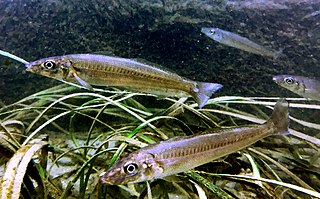 W
WThe Japanese whiting, Sillago japonica, is a common species of coastal marine fish belonging to the smelt-whiting family, Sillaginidae. As suggested by its name, the Japanese whiting was first recorded from Japan in 1843, but has subsequently been found to extend to Korea, China and Taiwan.
 W
WThe Khanka spiny bitterling is a temperate freshwater fish belonging to the Acheilognathinae subfamily of the family Cyprinidae. It originates in the inland rivers in Asia, and is found in China, Korea, and Russia. It is currently the only known species in its genus.
 W
WThe lake minnow or swamp minnow is a Eurasian species of small freshwater cyprinid fish. It has a wide but disjunct distribution including parts of Europe and Asia.
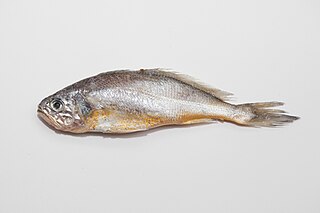 W
WLarimichthys polyactis, called the redlip croaker, small yellow croaker, little yellow croaker or yellow corvina, is a species of croaker native to the western Pacific, generally in temperate waters such as the East China Sea and the Yellow Sea.
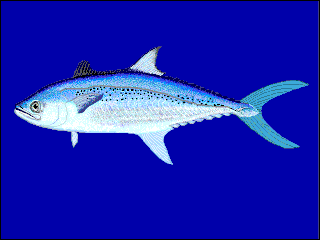 W
WThe Korean mackerel also known as the Korean seerfish, is a ray-finned bony fish in the family Scombridae, better known as the mackerel family. More specifically, this fish is a member of the tribe Scomberomorini, the Spanish mackerels. It has an Indo-Pacific distribution which extends from the east coast of India and Sri Lanka along the Asian continental shelf to Sumatra then north to Korea and Wakasa Bay in the Sea of Japan. This species is of minor commercial importance in some parts of its range where it is taken using gill nets and is marketed either fresh or dried-salted. The Korean mackerel is an important quarry species for the drift net fishery in Palk Bay and the Gulf of Mannar in India.
 W
WThe pond loach,, is a freshwater fish in the loach family Cobitidae. They are native to East Asia but are also popular as an aquarium fish and introduced elsewhere in Asia and to Europe, North America and Australia. The alternate name weather loach is shared with several other Cobitidae, including the other members of the genus Misgurnus and the spotted weather loach. This term comes from their ability to detect changes in barometric pressure and react with frantic swimming or standing on end. This is because before a storm the barometric pressure changes, and this is known to make these fish more active. The pond loach also comes in a variety of colors, such as pink, orange, albino and gray. The largest dojo loach raised in an aquarium recorded was recently discovered in a Nova Scotian home measuring at 8.46 Inches long.
 W
WThe Bloch's gizzard shad, also known as gizzard shad, hairback, long-finned gizzard shad, long-ray bony bream and thread-finned gizzard shad, are a widespread and common, small to medium-sized anadromous fish found in all marine, freshwater and brackish waters throughout Indo-West Pacific, towards eastward of Andaman Sea, South China Sea and the Philippines to Korean peninsula. Single specimen recorded from waters of South Africa. It was described by Marcus Elieser Bloch in 1795.
 W
WThe northern snakehead is a species of snakehead fish native to China, Russia, North Korea, and South Korea, ranging from the Amur River to Hainan. It has been introduced to other regions, where it is considered invasive. In Europe, the first report of the species was from Czechoslovakia in 1956. In the United States, the fish is considered to be a highly invasive species. In a well-known incident, several were found in a pond in Crofton, Maryland, in June 2002, which led to major media coverage and three movies.
 W
WThe olive flounder, bastard halibut or Japanese halibut is a temperate marine species of large-tooth flounder native to the North-western Pacific Ocean.
 W
WThe Pacific cod, Gadus macrocephalus, is a species of ray-finned fish in the family Gadidae. It is a bottom-dwelling fish found in the northern Pacific Ocean, mainly on the continental shelf and upper slopes, to depths of about 900 m (3,000 ft). It can grow to a length of a meter or so and is found in large schools. It is an important commercial food species and is also known as gray cod or grey cod, and grayfish or greyfish. Fishing for this species is regulated with quotas being allotted for hook and line fishing, pots, and bottom trawls.
 W
WThe Pacific herring, Clupea pallasii, is a species of the herring family associated with the Pacific Ocean environment of North America and northeast Asia. It is a silvery fish with unspined fins and a deeply forked caudal fin. The distribution is widely along the California coast from Baja California north to Alaska and the Bering Sea; in Asia the distribution is south to Japan. Clupea pallasii is considered a keystone species because of its very high productivity and interactions with many predators and prey. Pacific herring spawn in variable seasons, but often in the early part of the year in intertidal and sub-tidal environments, commonly on eelgrass, seaweed or other submerged vegetation; however, they do not die after spawning, but can breed in successive years. According to government sources, the Pacific herring fishery collapsed in the year 1993, and is slowly recovering to commercial viability in several North American stock areas. The species is named for Peter Simon Pallas, a noted German naturalist and explorer.
 W
WPagrus major, the red seabream is a fish species in the family Sparidae. In Japan, Pagrus major is known as madai and is prized both for its flavor and for its traditional use as an auspicious food, often served at New Year's and at festive occasions such as weddings. In Korea, it is known as domi (도미) or chamdom. Successful sumo wrestlers are often photographed holding the fish. It is also the most commonly eaten fish in Taiwan. Habitat preference is genetically coded in juveniles, which helps them to choose the optimal microhabitat in a fluctuating environment. Habitat preference is only observed in juvenile fish up to the age of 30 days, while adult fish do not show any habitat preference.
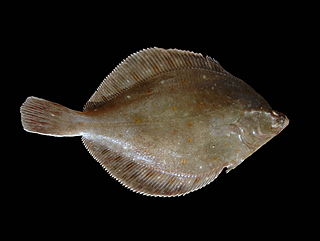 W
WPleuronectidae, also known as righteye flounders, are a family of flounders. They are called "righteye flounders" because most species lie on the sea bottom on their left sides, with both eyes on their right sides. The Paralichthyidae are the opposite, with their eyes on the left side. A small number of species in Pleuronectidae can also have their eyes on the left side, notably the members of the genus Platichthys.
 W
WThe Japanese sleeper ray is a species of electric ray in the family Narkidae. It is common in the inshore and offshore waters of the northwestern Pacific Ocean from southern Japan to southern China. Growing up to 40 cm (16 in) long, the Japanese sleeper ray has a nearly circular pectoral fin disc colored reddish to chocolate brown above, sometimes with darker or lighter spots, and lighter brown below. The spiracles behind its small eyes have raised, smooth rims. Its short and muscular tail bears a single dorsal fin positioned aft of the rounded pelvic fins, and terminates in a large caudal fin.
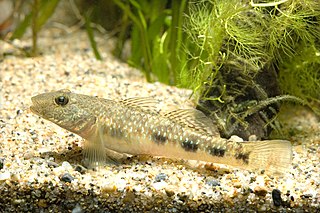 W
WRhinogobius giurinus is a species of goby native to eastern Asia where it inhabits marine, brackish and fresh waters of rivers and estuaries. This species can reach a length of 8 centimetres (3.1 in) TL. It is of importance to local peoples as a food fish.
 W
WSardinella zunasi is a species of ray-finned fish in the family Clupeidae, the herrings and sardines. It is native to the northwestern Pacific Ocean, where it occurs near shore along the Asian coastlines from southern Japan to Taiwan.
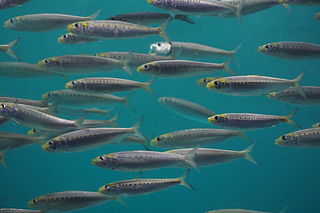 W
WSardinops is a monotypic genus of sardines of the family Clupeidae. The only member of the genus is Sardinops sagax. It is found in the Indo-Pacific and East Pacific oceans. Its length is up to 40 cm (16 in). It has numerous common or vernacular names, some of which more appropriately refer to subspecies, including blue pilchard, Australian pilchard, blue-bait, Californian pilchard, Peruvian Pacific sardine(S. s. sagax), South American pilchard, Chilean sardine, Japanese pilchard, Pacific sardine, and Southern African pilchard.
 W
WThe blackfin seabass is a Perciforme fish in the family lateolabracidae, found primarily in the shallow waters of the Pacific coast of Asia, in Japan and in South Korea. There are only two species in the genus Lateolabrax, known as Asian seabasses. As a perciforme, the blackfin seabass is among the largest order of fish in the ocean. Blackfin seabass live in shallow, tidal or rocky surf zones, partially as a way to escape competition with the Japanese seabass Lateolabrax japonicus, a close and almost identical relative of theirs, and partially for the breeding opportunity in brackish water by the mouths of rivers.
 W
WSebastes inermis is a species of rockfish native to the northwestern Pacific Ocean, where it occurs off the coasts of Japan and the Korean Peninsula. This species grows to a total length of 35 cm (14 in), and the heaviest recorded specimen weighed 800 g (1.8 lb). This fish is important to both commercial fisheries and the sport-fishing industry. It is also raised to supply market demand. The Japanese seaperches are twice as expensive as European seabass. Sometimes, the Japanese red seaperch is mixed up with Japanese black seaperch and Japanese seabass.
 W
WThe ocellate spot skate, also known as the spiny rasp skate or swarthy skate, is a species of skate in the family Rajidae and is commonly found in the north-western Pacific Ocean. O. kenojei is a bottom-feeding carnivore that consumes mainly shrimp, fishes, and crabs. Its diet also includes small quantities of amphipods, mysids, cephalopods, euphausiids, copepods, isopods, and polychaetes.
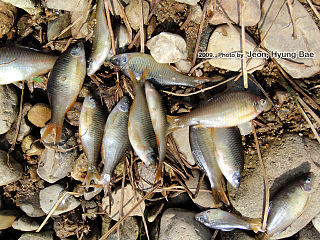 W
WTanakia koreensis is a cyprinid found in Korea which can grow to a size of 8 centimeters.
 W
WTanakia lanceolata is a temperate freshwater fish belonging to the Acheilognathinae sub-family of the family Cyprinidae. It originates in inland waterways in China, Japan and the Korean peninsula. It was originally described as Capoeta lanceolata by Temminck & Schlegel in 1846, and has also been referred to as Acheilognathus lanceolata and Acheilognathus lanceolatus in scientific publications. Its Korean name is 납자루, and in Japanese is known as ヤリタナゴ